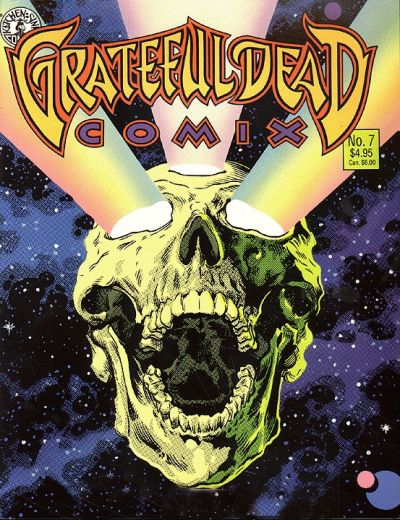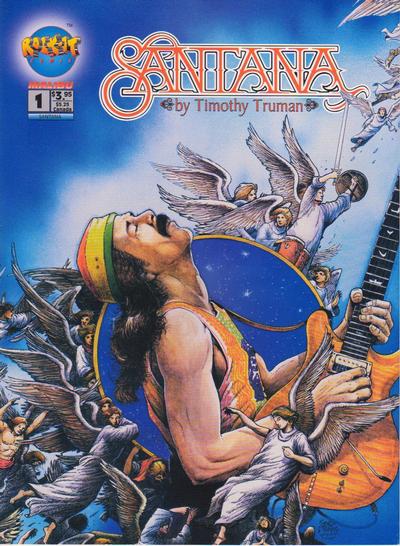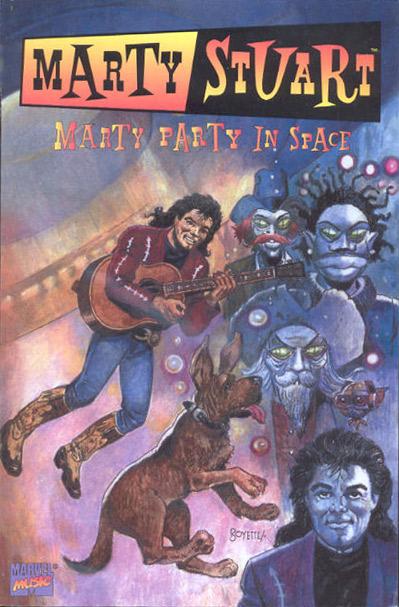In the early 1990s, the comic market was exploding. New publishers were springing up in an attempt to catch a piece of the craze, existing companies were introducing new titles right and left, investors were entering the field and speculating on which books would rise quickly in value, collectors gobbling up whatever new gimmick was shoved down their throats. The music industry was experiencing a similar boom at this time, with CD sales hitting an all time high, MTV at the height of its influence, and record companies and concert promoters collecting unheard of profits. Once again, rock and roll and comic books were on parallel paths, and it was inevitable that there would be a new burst of synergy between the two media. The preceding years had seen the commercial success of the unauthorized music biography series Rock ‘N’ Roll Comics, which brought its publisher Revolutionary Comics media attention, circulation numbers in the tens of thousands, and lawsuits from the artists profiled. Clearly there was a market for product of this kind, and despite the low quality of story and art in most issues, RNR Comics would go on to enjoy a long and profitable run.
Independent publisher Kitchen Sink set a precedent for artist-licensed books when they began Grateful Dead Comix in 1991, enlisting top-level talent to adapt and illustrate the band’s lyrics, and to craft new stories related to their long and fabled history. Artists participating included Tim Truman, Gilbert Shelton, Wayno, Nina Paley, Moebius, and other notables. The first couple of issues sold well, and from there, it was just a matter of time before other companies took notice and hopped on the bandwagon.
The first comics company to latch onto the new confluence of popularity was California-based Malibu Comics. In 1993, they partnered with music powerhouse Gold Mountain Management and launched Rock-It Comics, an imprint for new series devoted to popular musicians. Among the handful of titles they released were a Metallica biography comic, an issue of “Lita Ford: Heavy Metal Queen” (featuring the former Runaway as a guitar-wielding super-powered avenger), a Pantera comic full of demonic insanity, companion volumes devoted to Black Sabbath and Ozzy Osbourne, a book devoted to World Domination Recordings. In May of 1994, they issued a Santana biography by noted artist Tim Truman, detailing the guitarist’s views on his life, career, and search for enlightenment through psychedelically-illustrated interview transcripts. The Rock-It imprint folded shortly thereafter when Malibu was acquired by Marvel Comics; announced but never released were series featuring The Doors, Anthrax, Megadeth, Primus, Soundgarden, Yes, The Smithereens, and hip-hop acts Naughty By Nature, P.M. Dawn and The Pharcyde.
Meanwhile, Marvel Comics had already noticed the excitement around music comics and created their own in-house department for rock and roll publications. In June of 1994, they began releasing titles under the Marvel Music label. First out the gate was a three issue series by the writer/artist team of Neil Gaiman and Michael Zulli, entitled Alice Cooper: The Last Temptation (which tied into Alice’s then-new The Last Temptation album). Gaiman’s lyrical script and Zulli’s beautifully detailed art were a fine fit for the story’s gothic themes, and the comic kicked off the new cross-media venture in fine fashion.
The rest of the Marvel Music line proved to be a mixed bag: A Bob Marley series was launched amid much PR hype, but received mixed reviews and only the first two issues ever saw print. A Marty Stuart one-shot, Marty Party In Space, featured the country star battling aliens for control of a magic ring. The Saturday Morning compilation CD tie-in featured a great assortment of musicians and bands (and is reviewed in greater detail here). KRS-ONE’s Break The Chain one-shot was written and illustrated by the esteemed Kyle Baker, came packaged with an exclusive cassette single, and featured awesomely kinetic artwork and a message of cultural awareness and empowerment. A Billy Ray Cyrus book was released (featuring the one-hit country wonder cavorting with knights in the middle ages), as was one starring hardcore hip-hoppers Onyx (Fight, wherein the trio of MCs jet to a far-off planet and blow things up). And then there’s the Woodstock 1969-1994 comic, which barely mentions music and instead spins a yarn about 30th century teenagers going back in time to gawk at a bunch of hippies.
Finally, there’s the squarebound one-shot Rolling Stones: Voodoo Lounge by Dave McKean. It’s a story… Well, not so much a story as a vignette… Well, it’s a… Thing. A thing about supernatural stuff, and desire and seduction and ham-fisted sexual half-entendres, set in a city of bad dreams and dilapidated watering holes. (I’m assuming it’s supposed to be New Orleans, though not the real one… The imaginary New Orleans from horror stories and folk tales and old Rolling Stones songs.) The text is made up of lyrics from the Voodoo Lounge record, woven together into a vague tapestry of gothic doomishness, wound around McKean’s breathtaking images of silhouetted lovers and dreams disappearing in flames. It’s an odd piece: not quite a comic book, not exactly a story book, and certainly not a sensibly commercial creation. But it’s dark, and it’s creepy, and The Stones loom throughout, their faces narrating, mixing with characters, and filling in backgrounds when there’s space left on the page. It may not make any sense, but it’s a fascinating and unique addition to the shelves of any comic and/or music aficionado.
Rock-It Comics published a total of eight comics (seven individual artist books and one multi-artist preview sampler), from mid 1993 to mid 1994. Kitchen Sink published nine issues of Grateful Dead Comix between 1991 and 1994 (seven oversized issues of series one, two regular comic format issues of series two). None of the above are in print, but all can usually be found at comic shops or on eBay. Marvel Music published a dozen comics, and also a trade paperback reprinting the KISS Marvel comics from the 70s. Sources for this article include: The Los Angeles Times, August 21, 1993; Billboard, May 14, 1994; Billboard, September 4, 1993; San Diego Reader, September 12, 2007
All articles in the Pop Music Comics series can be found here.





